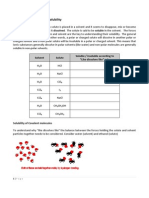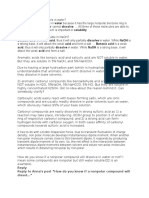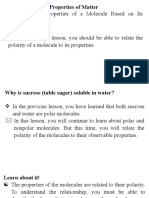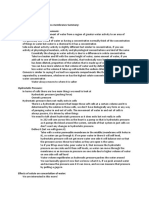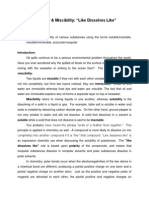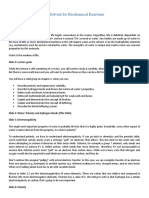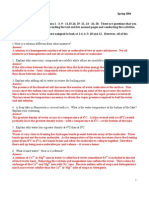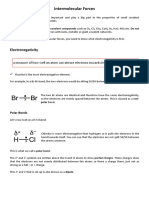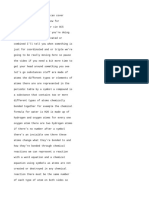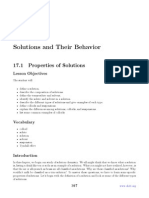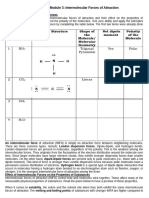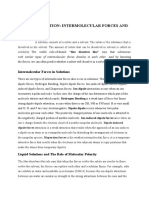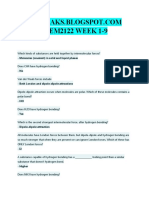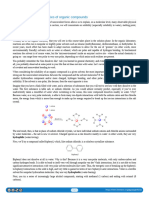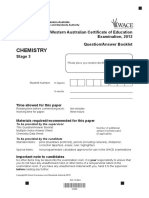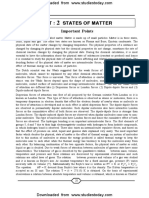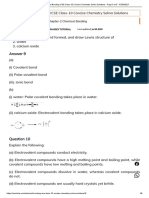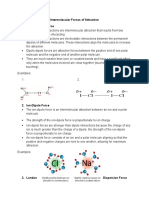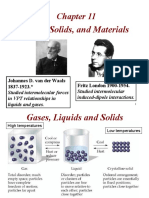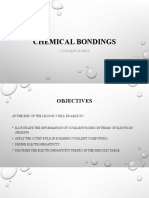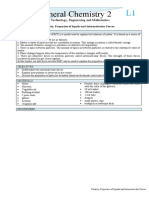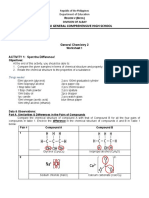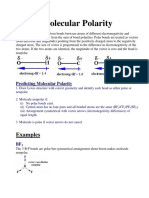Acetic Acid CFQ 8
Acetic Acid CFQ 8
Uploaded by
Olivia Rae IrvingCopyright:
Available Formats
Acetic Acid CFQ 8
Acetic Acid CFQ 8
Uploaded by
Olivia Rae IrvingOriginal Title
Copyright
Available Formats
Share this document
Did you find this document useful?
Is this content inappropriate?
Copyright:
Available Formats
Acetic Acid CFQ 8
Acetic Acid CFQ 8
Uploaded by
Olivia Rae IrvingCopyright:
Available Formats
Acetic Acid, Which solvent works?
Cfq #8 student explanation
We have:
Acetic Acid
In this?
OR! Water
Or
Solubility occurs when the attractive forces are greater between the two molecules of two substances (A and B) than the attractive forces among the molecules of the pure substances A and B. But what does this really mean? Well, we are talking about intermolecular forces or the forces between molecules, not within them. So molecule A in this case lets calls Acetic Acid and molecules B could be: Our B can be glycerol tristearate or water Call water B and glycerol B and we will choose which one would the acetic acid be more soluble in. We first want to consider the properties of each molecule and what attractive forces could be at work between acetic acid and these two solvents between like
So we have acetic acid and water: As shown above both are polar molecules This is just to let you remember when we have mixed water and acetic acid and the next section is on acid and bases why not look at a relevant reaction that might help jog your memory of the solubility of acetic acid in water.
While we know acetic acid is a weak acid, it still has a dipole, as well does water. These dipoles arent transient like when dealing with a non-polar molecule and therefore when combined ( acetic acid and water) the attractive forces between the water molecules and the acetic acid molecules are stronger than the individual intermolecular forces if we just had acetic acid purely or water purely. There are various intermolecular forces at work: Dipole-dipole Partial charges of polar molcules H bonded to N, O, or F, and another N, O, or F Induced dipoles of polarizable molecules 25 5 40 10 HCl & HCl H2O & NH3 Xe & Xe
Hydrogen bond
London dispersion
40 0.05
While London dispersion forces are relatively weak we do have the hydrogen bonding and dipole-dipole interactions which are not weak. Therefore the interactions between A (acetic acid) and B (water) outweigh the intermolecular interactions if we just those pure substances this meaning
Acetic acid alone
water alone
add some acetic acid to water
Yay ! The intermolecular forces when I mix acetic and B occur in one phase and therefore acetic acid which is also polar! acid and water are stronger! Hence A a polar molecule is soluble in water
Note : cartoons are for fun, the equipment used and color of liquids are not to be taking to be correct or judged. Its a cartoon. Now to discuss Glycerol Tristearate and Acetic Acid.
As we can see we have the reaction of how we get Glycerol Tristearate, I thought this might be helpful to show you how these two polar molecules glycerol and steric acid come together to form a non-polar lipid glycerol Tristearate. Heres a link to read about non polar lipids.
http://chemed.chem.wisc.edu/chempaths/GenChem-Textbook/Nonpolar-Lipids-1018.html
This molecule has quite a lot of symmetry actually. One could deduce it is probably non polar or less polar simply from looking at the middle CH part of the molecule and evaluating the symetricalness from there.
If one doesnt see this and instead considers the esters to be polar, also take into account the long non polar hydrocarbon chains will probably outweigh the polarity of these regions. This molecule is less polar than acetic acid and less polar than water which is pretty easy to see. We know that like dissolves like. But beyond this , like said in the think book, the glycerols interaction with other molecules through London dispersion forces is larger than dipole forces (this means very weak dipole forces) . This is because there isnt a significant separation of charge in glycerol tristearate which would be needed in order to form a strong dipole-dipole interaction with another nonglycerol tristearate molecule such as acetic acid. The interactions that would occur within a glycerol tristearate and acetic acid mixture would mainly be London dispersion forces which would be relatively weak between these two molecules. Think about it. Think of it like this we have a beaker of glycerol tristearate. The induced or momentary dipoles within the glycerol tristearate would be weak and momentary. In comparison we have polar molecules of acetic acid in a beaker. These molecules have dipole-dipole interactions among themselves that are stronger than London dispersion forces alone. NOW back to the original idea of solubility To have solubility occur we need the attractive forces between the molecules of glycerol and acetic acid to be stronger than the attractive forces in each pure substance alone. How shall a substance such as glycerol tristearate with weak molecular forces when alone, and no strong dipole-dipole interactions, perform as a solvent when acetic acid which has strong dipole-dipole interactions when alone is dissolved in it!? Poorly, the attractive forces (London dispersion) between the acetic acid molecules and glycerol tristearate arent enough to overcome the forces within each pure substance. Weigh the option of acetic acid alone and with glycerol tristearate.
Choice A: Acetic acid molecules alone, nothing else, pure: dipole-dipole intermolecular forces Choice B: Acetic acid interaction with glycerol tristearate: London dispersion
London dispersion < dipole-dipole . Hence acetic acid has a low solubility in glycerol tristearate.
You might also like
- Ebook PDF Chemistry The Central Science 13th Edition PDFDocument41 pagesEbook PDF Chemistry The Central Science 13th Edition PDFbruce.roth34998% (50)
- Experiment 1 (Solubility and Miscibility)Document10 pagesExperiment 1 (Solubility and Miscibility)Yee Mun Kum100% (1)
- C 10ef 2 0 Explain StemscopediaDocument7 pagesC 10ef 2 0 Explain Stemscopediaapi-2368267470% (1)
- Solubility and Polarity C11!4!5Document8 pagesSolubility and Polarity C11!4!5doctorguy770% (1)
- 4.5 SolubilityDocument6 pages4.5 SolubilityAranganayagam K RamasamyNo ratings yet
- How Do You Know If A Nonpolar Compound Will Dissolve in Water or Not? I Mean Some Compounds Are Nonpolar But Still Water Soluble (O2 Is An Example)Document5 pagesHow Do You Know If A Nonpolar Compound Will Dissolve in Water or Not? I Mean Some Compounds Are Nonpolar But Still Water Soluble (O2 Is An Example)JEAN I MAGLAQUENo ratings yet
- Solution, Suspension, ColloidsDocument149 pagesSolution, Suspension, ColloidsApril Eballena100% (1)
- Unit 4 Solubility & SolventsDocument105 pagesUnit 4 Solubility & SolventskloaizarNo ratings yet
- Chapter 06 - Forces in SolutionsDocument47 pagesChapter 06 - Forces in Solutionsseif MohsenNo ratings yet
- Physical Science Module 4Document12 pagesPhysical Science Module 4Agatsuma KylineNo ratings yet
- 2023 Aqueous SolutionsDocument45 pages2023 Aqueous Solutionsaydonjoseph1No ratings yet
- What Is A SolutionDocument5 pagesWhat Is A SolutionaizaNo ratings yet
- Solution, Solubility and Factors Affecting SolubilityDocument6 pagesSolution, Solubility and Factors Affecting Solubilityshehryar khanNo ratings yet
- CHM 221 Factors Affecting Structure and Physical Properties of Organic Compounds NewDocument32 pagesCHM 221 Factors Affecting Structure and Physical Properties of Organic Compounds NewHannah Coker100% (2)
- Chapter 7 Lecture Notes: Solutions, Colloids, and SuspensionsDocument44 pagesChapter 7 Lecture Notes: Solutions, Colloids, and SuspensionstitusNo ratings yet
- Lesson 3.2 The Properties of A Molecule Based On Its PolarityDocument23 pagesLesson 3.2 The Properties of A Molecule Based On Its PolarityMelanie MirandaNo ratings yet
- Sol and Misc LasDocument5 pagesSol and Misc LasJoHan Xyth RizaldoNo ratings yet
- L3 - Water Across MembraneDocument7 pagesL3 - Water Across MembraneLogan SalisburyNo ratings yet
- 0 - CH 6 - SolutionsDocument59 pages0 - CH 6 - SolutionsHazel OrionNo ratings yet
- Water, Polarity, and Dissolving - Student ReadingDocument8 pagesWater, Polarity, and Dissolving - Student Readingapi-279918311No ratings yet
- Chem 31.1 FG Post Lab Group 4 Expt. 2Document10 pagesChem 31.1 FG Post Lab Group 4 Expt. 2lazygemNo ratings yet
- Physical Science ReportDocument35 pagesPhysical Science Reportadrian lozanoNo ratings yet
- Vitamin CDocument1 pageVitamin CJ-eliNo ratings yet
- Sample IntroductionDocument12 pagesSample Introductionapi-289866381No ratings yet
- Solubility & Miscibility AbsentDocument3 pagesSolubility & Miscibility AbsentRizky Teddy AudinnoNo ratings yet
- Intermolecular ForcesDocument4 pagesIntermolecular ForcesAgathaNo ratings yet
- Transcript For Water LectureDocument5 pagesTranscript For Water Lecturestanly sotoNo ratings yet
- Chapter 13Document29 pagesChapter 13Muhammad iqbalNo ratings yet
- Physical Science - CH 11Document5 pagesPhysical Science - CH 11suhughes100% (5)
- Acids and BasesDocument6 pagesAcids and BaseshexaminaNo ratings yet
- Intermolecular Forces EdexcelDocument6 pagesIntermolecular Forces EdexcelKevin The Chemistry Tutor100% (2)
- (English (Auto-Generated) ) All of CIE CHEMISTRY in 45 Mins - International iGCSE Science Revision (DownSub - Com)Document46 pages(English (Auto-Generated) ) All of CIE CHEMISTRY in 45 Mins - International iGCSE Science Revision (DownSub - Com)t.dyakivNo ratings yet
- Chemistry - Solutions and Their BehaviorDocument48 pagesChemistry - Solutions and Their BehaviorMohdErwanNo ratings yet
- Appendix E - Polarity WorksheetDocument3 pagesAppendix E - Polarity WorksheetshafferjfNo ratings yet
- Lesson 2.2 The Properties of A Molecule Based On Its PolarityDocument23 pagesLesson 2.2 The Properties of A Molecule Based On Its PolarityJofel CañadaNo ratings yet
- 1-Chem 1002 (Ch2)Document46 pages1-Chem 1002 (Ch2)thandarthandarwin1991No ratings yet
- Experiment No 7 Grp3 Gutierrez, Crisha Andrea MDocument4 pagesExperiment No 7 Grp3 Gutierrez, Crisha Andrea MCrisha GutierrezNo ratings yet
- Monoacidic BaseDocument19 pagesMonoacidic BaseAlou CroduaNo ratings yet
- Physical Science Q4- CALUNADocument5 pagesPhysical Science Q4- CALUNAArnaly Barde Villarin AlayonNo ratings yet
- 8 Chapter 12 1Document51 pages8 Chapter 12 1azizNo ratings yet
- Hydrophobic Effect PDFDocument6 pagesHydrophobic Effect PDFPrateek DwivediNo ratings yet
- The Extraordinary Properties of Ordinary Solutions Fialkov MIRDocument110 pagesThe Extraordinary Properties of Ordinary Solutions Fialkov MIRstreetba100% (1)
- Why Do Oil and Water Mixed Together Separate Into LayersDocument2 pagesWhy Do Oil and Water Mixed Together Separate Into LayersShahir AshuNo ratings yet
- Study Guide 7Document31 pagesStudy Guide 7Dominador RomuloNo ratings yet
- Unit 3 Solutions POWERPOINT 3Document81 pagesUnit 3 Solutions POWERPOINT 3Jenny YoonNo ratings yet
- WaterDocument22 pagesWaterNana tseredianiNo ratings yet
- CHEM 101 RECITATION 7.4 NotesDocument2 pagesCHEM 101 RECITATION 7.4 NotesCedra AliNo ratings yet
- Lecture 02Document24 pagesLecture 02kblawan03No ratings yet
- Water NotesDocument5 pagesWater NotesYaron SaksNo ratings yet
- SECTION 13.1 Types of Solution: Intermolecular Forces and SolubilityDocument2 pagesSECTION 13.1 Types of Solution: Intermolecular Forces and SolubilityRafiqNo ratings yet
- Understanding Intermolecular Forces in Organic Chemistry DSADocument6 pagesUnderstanding Intermolecular Forces in Organic Chemistry DSAprettydube3131No ratings yet
- Chemistry Week 1-9Document15 pagesChemistry Week 1-9kylaNo ratings yet
- (AMALEAKS - BLOGSPOT.COM) CHEM2122 Week 1-9Document15 pages(AMALEAKS - BLOGSPOT.COM) CHEM2122 Week 1-9Jason NeighNo ratings yet
- The Lava LampDocument5 pagesThe Lava LampMathew DegamoNo ratings yet
- Physical Properties of Organic CompoundsDocument9 pagesPhysical Properties of Organic CompoundscHeMiStRy fLoWNo ratings yet
- Chapter 13 The Properties of Mixtures: Solutions and ColloidsDocument33 pagesChapter 13 The Properties of Mixtures: Solutions and ColloidsGregNo ratings yet
- UNIT-II PP-I SOLUBILITY OF DRUGS (1)Document22 pagesUNIT-II PP-I SOLUBILITY OF DRUGS (1)puthiharshitha9No ratings yet
- Physical Properties of SolutionsDocument28 pagesPhysical Properties of SolutionsMA RI AHNo ratings yet
- Matter Test Study Guide KeyDocument26 pagesMatter Test Study Guide Keyapi-278594802No ratings yet
- The Big Chemistry Book on Solutions - Chemistry for 4th Graders | Children's Chemistry BooksFrom EverandThe Big Chemistry Book on Solutions - Chemistry for 4th Graders | Children's Chemistry BooksNo ratings yet
- O Level Chemistry for Cambridge Students: 2024 and 2025 EditionFrom EverandO Level Chemistry for Cambridge Students: 2024 and 2025 EditionNo ratings yet
- Third Periodic Test in Physical ScienceDocument7 pagesThird Periodic Test in Physical ScienceRey Mark QueanoNo ratings yet
- Chemistry Stage 3 Exam 2012Document40 pagesChemistry Stage 3 Exam 2012Naomi David NewNo ratings yet
- Unit: 2 States of Matter: Important PointsDocument24 pagesUnit: 2 States of Matter: Important PointsManish SinghNo ratings yet
- Chemical Bonding ICSE Class-10 Concise Chemistry Selina Solutions - Page 3 of 5 - ICSEHELPDocument6 pagesChemical Bonding ICSE Class-10 Concise Chemistry Selina Solutions - Page 3 of 5 - ICSEHELPlionelkenethNo ratings yet
- A Review On Cyclodextrin Encapsulation of Essential Oils and VolatilesDocument15 pagesA Review On Cyclodextrin Encapsulation of Essential Oils and VolatilesAmanda Pujiastuti0% (1)
- Intermolecular Forces of Attraction 1. Dipole-Dipole ForceDocument2 pagesIntermolecular Forces of Attraction 1. Dipole-Dipole ForceNica GamesNo ratings yet
- Handson Day3 DFPTDocument46 pagesHandson Day3 DFPTyapiNo ratings yet
- Lecture 1 LIF101 2022-Introduction and Life Chemical BasisDocument36 pagesLecture 1 LIF101 2022-Introduction and Life Chemical BasisAkshat TiwariNo ratings yet
- Chemical BondingDocument50 pagesChemical BondingLeila BonNo ratings yet
- Liquids, Solids, and Materials: Fritz London 1900-1954. Johannes D. Van Der Waals 1837-1923.Document41 pagesLiquids, Solids, and Materials: Fritz London 1900-1954. Johannes D. Van Der Waals 1837-1923.ade dosmariaNo ratings yet
- Biochemistry Test 1 ReviewDocument11 pagesBiochemistry Test 1 ReviewAnup Regunathan100% (1)
- Adamjee Chemistry XDocument3 pagesAdamjee Chemistry XRafiq AfridiNo ratings yet
- A1.1 WaterDocument42 pagesA1.1 WaterKumutha ChelliahNo ratings yet
- Plus Two Physics Full Chapters-Seema TRDocument219 pagesPlus Two Physics Full Chapters-Seema TRanjimarv43No ratings yet
- CH13 AnswersDocument22 pagesCH13 AnswersjasminesangelNo ratings yet
- Molecules 27 03690 v2Document31 pagesMolecules 27 03690 v2rafelNo ratings yet
- Bayla (Las 5)Document7 pagesBayla (Las 5)Zeian Jacob BaylaNo ratings yet
- Literature For Canvas Tests ChemistryDocument24 pagesLiterature For Canvas Tests Chemistryrio kurniaNo ratings yet
- CH 2 Study GuideDocument8 pagesCH 2 Study GuideEmiliano Arvizu Franco JrNo ratings yet
- Chemical Bonding LectureDocument7 pagesChemical Bonding LectureSymonette OcturaNo ratings yet
- Bond PolarityDocument9 pagesBond PolarityIvy LunaNo ratings yet
- Moral Dilemma EssayDocument8 pagesMoral Dilemma Essaylvwfzlaeg100% (2)
- Study Guide 7Document31 pagesStudy Guide 7Dominador RomuloNo ratings yet
- Chemical Bonds CovalentDocument32 pagesChemical Bonds CovalentAlekhoy PakzNo ratings yet
- L1-Intermolecular-Forces Gen ChemDocument13 pagesL1-Intermolecular-Forces Gen ChemOohAngelNo ratings yet
- Gen Chem 2 W1 CompleteDocument11 pagesGen Chem 2 W1 CompleteMary Bernadeth S. PeligresNo ratings yet
- Module GDocument15 pagesModule GDaniellhy 10No ratings yet
- Molecularpolarity PDFDocument4 pagesMolecularpolarity PDFTea RadicNo ratings yet
- 962 Chemistry (PPU) Semester 1 TopicsDocument9 pages962 Chemistry (PPU) Semester 1 TopicsJosh, LRTNo ratings yet




